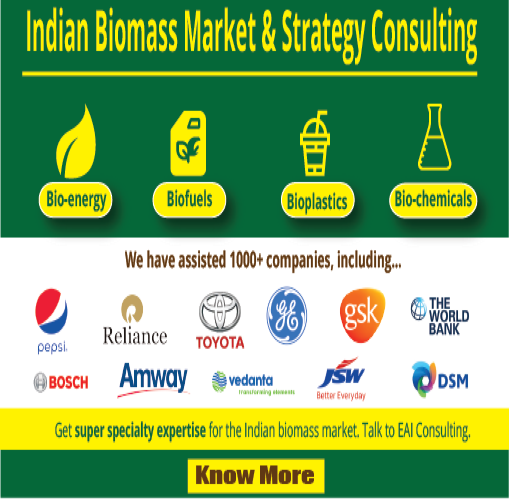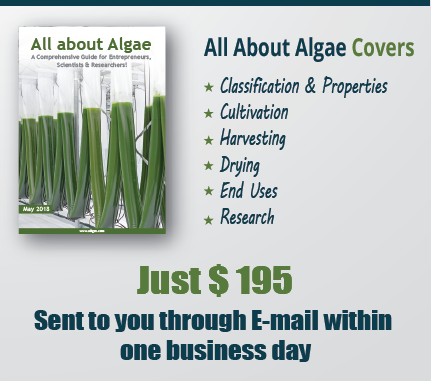|
Properties |
Biodiesel from Microalgal Oil |
Diesel Fuel |
|
Density Kg l-1 |
0.864 |
0.838 |
|
Viscosity Pa s |
5.2×10-4 (40 ēC) |
1.9 - 4.1 ×10-4 (40 ēC) |
|
Flash point ēC |
65-115* |
75 |
|
Solidifying point ēC |
-12 |
-50 - 10 |
|
Cold filter plugging point ēC |
-11 |
-3.0 (- 6.7 max) |
|
Acid value mg KOH g-1 |
0.374 |
0.5 max |
|
Heating value MJ kg-1 |
41 |
40 - 45 |
|
HC ratio |
1.18 |
1.18 |
*: Based on data from multiple sources
Source: Department of Biological Sciences and Biotechnology, Tsinghua University, Beijing , China (2004)
Increasing the Oil Yields from Algae
Yields from algae are much higher than those from other oil crops and there is a huge potential to increase this high yield even further
To improve lipid yields in Microalgae one must understand the physiological and biochemical basis for partitioning photosynthetically fixed CO2 into lipids. The rate of lipid synthesis and final lipid yield will depend on the availability of carbon for lipid synthesis and the actual levels and activities of the enzymes used for lipid synthesis. Conditions such as nitrogen deficiency that induce the accumulation of lipid by algae often drastically reduce the capacity of photosynthetic CO2 fixation. Low lipid yields could result either from an absence of carbon skeletons or from low levels of enzymes. Improvements in lipid yield can be achieved only when the limiting factors have been determined.
Research efforts are continuing in order to determine the pathways of lipid biosynthesis in algal cells, especially in the cytoplasm, chloroplast and mitochondrion. Each pathway possesses potential lipid triggers. Once the trigger is determined, biochemical and genetic engineering techniques can be used to increase the lipid yield of promising algal strains.
To know more about Algae Oil Yields, buy our Comprehensive Oilgae report with its recent updated version. List of contents under this topic include:
Comparison of Yields from Algae with Other Oil Crops
Real-life Quotes for Oil Yield
Reasons behind High Algae Yields
Increasing the Oil Yields from Algae
Examples of Research & Case Studies of Increasing Oil Yields in Algae
See the following sections:
Reference: Chemistry & Structure of Fixed Oils
Fixed oils from seeds, nuts & vegetables are typically composed of triglyceride molecules (also known as triacylglycerol or triacylglyceride). A triglyceride is a glyceride in which the glycerol is esterified with three fatty acids - a triglyceride is typically composed of a 3-carbon alcohol (glycerol) plus three 18-carbon (or 16-carbon) fatty acids. The 18-carbon fatty acids are Linoleic acid, Stearic acid & Oleic acid.
- Glycerol + Three Fatty Acids = A Fat Molecule (Triglyceride)
- Linoleic Acid Polyunsaturated: 2 Double Bonds In The Molecule
- Stearic Acid Saturated: All Single Bonds Between Atoms Of Carbon
- Oleic Acid Monounsaturated: 1 Double Bond between Carbons 9 & 10
The fatty acids may be saturated (with all single bonds), mono-unsaturated (with one double bond) or polyunsaturated (with 2 or more double bonds). Plant fatty acids are usually unsaturated and liquid at room temperature, with one or more double bonds between the carbon atoms (mono-unsaturated and polyunsaturated). A notable exception is the palm fatty acid palmitin which is saturated and contains 16 rather than 18 carbon atoms. Since the plant fatty acids are unsaturated, the plant oils it is liquid at room temperature.
See also: Triglycerides from Wikipedia, Linoleic Acid from Wikipedia, Stearic Acid from Wikipedia, Oleic Acid Physical & Chemical Properties, Fats, Oils, Fatty Acids, Triglycerides Chemical Structure, See also: Food, Fats & Oils from ISEO (PDF), Determining the Contents of Oilseeds (PDF)
Cis & Trans Fatty Acids
Fatty acid isomers containing double bonds may have the cis or trans configuration. In cis fatty acids, all the hygrogen atoms adjacent to the double bonds are on the same side of the longitudinal carbon axis. In trans fatty acids, the hygrogen atoms adjacent to the double bonds occur on alternate sides of the main axis.
The trans configuration is chemically more stable. It is typically produced during partial hydrogenation of polyunsaturated vegetable oils.
Trans fatty acids tend to raise the level of low density lipoproteins (LDLs = bad) and lower the level of high density lipoproteins (HDLs = good). These changes in blood Lipids (cholesterol levels) may increase the risk of heart disease (atherosclerosis) in some people. Dieticians generally recommend the use of mono-unsaturated, unhydrogenated oils and the avoidance of trans fatty acids found in french fries, cookies and crackers.
Unsaturated fatty acids found in plant oils and seeds are typically omega-6 fatty acids, in which the first double bond is located on the sixth carbon atom, counting backwards from right to left. Omega-3 fatty acids in which the first double bond in on carbon #3 - are prevalent in fish oils and flax seeds.
- Chemical & Nutritional Properties of Olive Oil Olive Oil Source
- Algae New Source of Omega-3 Fats
- Trans Fatty Acids from American Heart Association
- The Influence of Trans Fatty Acids on Health (PDF)
- Trans Fatty Acids & Coronary Heart Disease Harvard School of Public Health
More articles & news on algal oil: Visitors may kindly have a look at the Oilgae Blog Directory for relevant blog articles.
Other Related Sections
Blue Green Algae, Red Algae, Green Algae, Marine Algae, String Algae, Pond Algae, Pond Algae Control, Algae Control
! Are you an inventor or equipment producer for fuel from algae, or part of a company that is involved in the algal fuel efforts? Please see this section in order that you can help us list your company or efforts @ OilgaeEnergy & Alternative Energy
Energy Portal Discussed topics such as alternative & renewable energy, peak oil, energy industry inventions & discoveries, and more.



